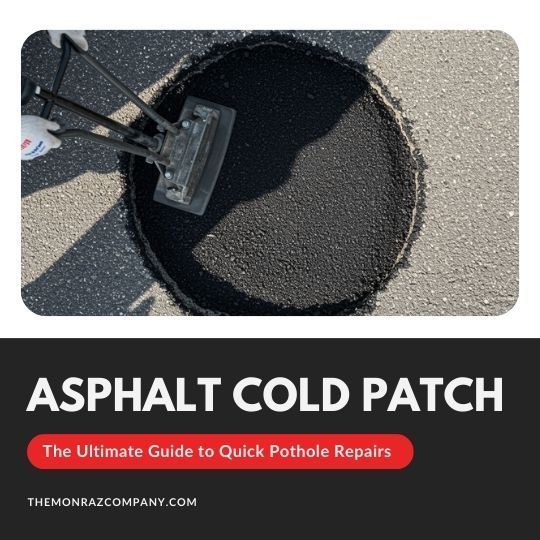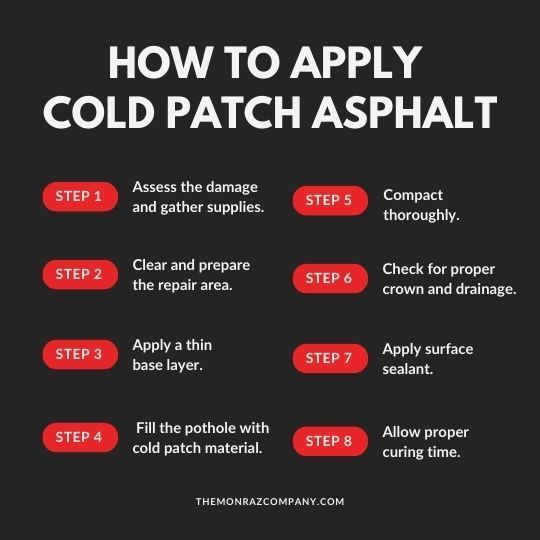Asphalt Cold Patch: The Ultimate Guide to Quick Pothole Repairs
Potholes and cracks in your commercial property's pavement aren't just eyesores; they're potential liabilities waiting to happen. When left unaddressed, these small imperfections quickly escalate into serious hazards that can damage vehicles, cause accidents, and even result in costly lawsuits. The good news? They can be corrected. Asphalt cold patching offers an immediate, effective solution that property managers can implement year-round.
If you’d like a quicker or more specific answer to your asphalt or concrete repair questions, call the experts at
TMC Engineering! If you’re in Southern California, we can help educate you on your problem and perform whatever repair is necessary. We’ve got an expert solution for your commercial concrete or asphalt concerns!

Asphalt Cold Patch: What to Expect
It's crucial to repair paving damage as soon as it appears. Every day you wait allows water, garbage, and vehicular traffic to enter and aggravate the damaged area, allowing the damage to expand and repair to multiply manifold. Although there are different types of repair, asphalt cold patch emerges as both useful and convenient for maintenance crews of commercial properties.
Here you'll find actionable data on cold patch asphalt that will shake up the way you currently do pavement repair on your business property. This article is full of expert recommendations, step-by-step instructions, and no-nonsense advice from industry experts.
Whether you're a property manager looking to handle minor repairs in-house or seeking to better understand your maintenance options, this information will help you make informed decisions about pavement upkeep that protect your investment and enhance property safety.
What Is Cold Patch Asphalt?
Cold patch asphalt is specifically designed for immediate use without the necessity of heating it. Unlike traditional hot mix asphalt, which must be transported and applied at high temperatures (typically around 300°F), cold patch can be handled at ambient temperatures making it an ideal choice for emergency repairs and maintenance jobs for commercial real estate.
This is a mixture of aggregate (mineral filler, sand, and small rocks) with a proprietary liquid asphalt binder that remains flexible at cooler temperatures. Manufacturers add solvents or emulsifying agents to the asphalt binder, which temporarily decrease its viscosity and allow it to spread over the aggregate nicely without the need for heat. This unique formula makes the patch malleable when applied, but hardens with time through a process referred to as "curing."
New cold patch products have evolved far beyond earlier versions, with some high-end performance products now rivaling the hot mix in durability. Premium cold asphalts often include polymer modifiers and proprietary additives to enhance adhesion, elasticity, and water resistance.
Cold patch asphalt is a good compromise between temporary and permanent repairs. What was once only used for temporary repairs now uses new formulas to produce long-term results when properly applied to defects in commercial property pavement that are of medium size.
How Does Cold Patch Asphalt Work?
Cold patch asphalt works through a curing process that is very different from the air-cooling caused by hardening of hot mix asphalt. When you fill a pothole with cold patch, several mechanisms begin simultaneously:
- Solvent Evaporation: Premium cold asphalts contain specifically selected solvents that keep the asphalt binder in a workable state during storage and use. When such solvents are left open to the atmosphere, they evaporate slowly, hardening the binder and bonding it to the aggregate.
2. Mechanical Compaction: With the traffic rolling over the repair area, it continues to compact the material, forcing air pockets out and causing it to become denser. Compaction is necessary for long-term strength and that is why proper initial tamping must be completed correctly when applying.
3. Cohesive Bonding: Cold patch asphalt binders are designed to form internal, strong bonds among aggregate particles during curing. Cohesive bonding leads to a cohesive mass resistant to traffic loads and environmental stress.
4. Adhesive Bonding: Proper cold patch mix designs develop adhesive bonds with the surrounding pavement edges, providing a seal excluding water intrusion and freeze-thaw damage.
Cold patch asphalt's success lies in its ability to maintain a degree of flexibility after it has cured. This flexing allows the repair to be able to move slightly along with the original pavement while being able to accommodate temperatures and traffic loads without cracking.
Cold patch materials used in commercial applications usually contain high-performance polymer modifiers that further improve such viscoelasticity to offer the ideal combination of flexibility and strength. Such polymers also notably enhance the material's cohesion, averting raveling (the progressive loss of aggregate from the surface) even under severe commercial traffic conditions.
Perhaps the most impressive thing about contemporary cold patching materials is that they will continue to strengthen over a period of time. As traffic compaction and environmental exposure test the repair further, most formulas actually become denser and harder, rendering them effectively permanent fixes and not short-term solutions.

How To Apply Cold Patch Asphalt
Step 1: Assess the damage and gather supplies.
Begin by evaluating the extent of the pavement damage. Cold patch works best for potholes and depressions between 1-3 inches deep. For your repair job, you'll need:
- Sufficient cold patch asphalt (approximately 50-60 pounds per square yard, per inch of depth)
- Square-point shovel or asphalt rake
- Push broom and wire brush
- Hand tamper or plate compactor
- Safety gear (gloves, safety glasses, reflective vest)
- Traffic cones for work area protection
Step 2: Clear and prepare the repair area.
Thoroughly clean the pothole of loose debris, vegetation, and standing water. Use a broom and wire brush to remove loose asphalt fragments and create a clean bonding surface. For optimal results, cut or chip away any crumbling edges to create a stable perimeter with relatively vertical sides. This "squared-off" preparation dramatically improves the durability of your asphalt patches.
Step 3: Apply a thin base layer.
For potholes deeper than 2 inches, apply cold patch asphalt in layers. Spread a thin initial layer approximately 1 inch thick across the bottom of the cleaned pothole. Compact this base layer thoroughly before proceeding, as this creates a solid foundation for your repair. Skipping this step for deep repairs often leads to excessive settlement and premature failure.
Step 4: Fill the pothole with cold patch material.
Pour the cold patch asphalt into the prepared pothole, creating a slight mound that extends about 1/2 inch above the surrounding pavement. This overfill compensates for the compaction that will occur under traffic. Distribute the material evenly using a rake or shovel, ensuring the repair material reaches all edges and corners of the damaged area.
Step 5: Compact thoroughly.
Compaction is the most critical step in achieving a durable asphalt repair. Use a hand tamper for smaller repairs or a plate compactor for larger areas. Work from the edges toward the center in a systematic pattern, applying firm, even pressure. For optimal results, compact until the patched surface is level with or slightly higher than the surrounding pavement. This thorough compaction eliminates air voids that would otherwise lead to premature deterioration.
Step 6: Check for proper crown and drainage.
After compaction, verify that your repair doesn't create a depression that could collect water. The finished patch should have a slight crown (approximately 1/8 inch higher than surrounding pavement) to accommodate final settling and ensure proper drainage. Water pooling on or around your repairs will significantly reduce their lifespan.
Step 7: Apply surface sealant.
For commercial properties with high-traffic areas, consider applying a compatible asphalt sealer around the perimeter of your newly completed repair. This creates an additional water-resistant barrier and helps blend the repair visually with the existing pavement, enhancing both function and appearance.
Step 8: Allow proper curing time.
While many cold patch products allow immediate traffic, minimizing heavy vehicle traffic for 24-48 hours significantly improves long-term performance. If possible, use traffic cones to direct traffic away from very fresh repairs, particularly in hot weather when the material remains somewhat pliable.

How To Get Cold Patch Asphalt To Harden
Compaction is key.
Most important to cold patch performance is closely compacted material. Pressure compacts particles together, forcing out air and allowing binding agents to work effectively. In commercial applications, use these compaction best practices:
- Make multiple passes rather than a single heavy pass.
- Compact in a series from the outside in.
- In high-traffic commercial areas, employ the use of a vibratory plate compactor rather than hand tamping.
- Allow car traffic to give further compaction upon initial installation.
Business establishments often treat newly compacted repair with a light dusting of sand by professional contractors. The sand is prevented from sticking into the tires of cars for some time and will pull loose oils towards the surface to where they can evaporate correctly.
Regulate water at application.
Moisture has a significant impact on the cold patch asphalt curing process. While most modern formulas are suitable for use in wet conditions, controlling excess moisture improves results:
- Drain standing water completely before applying.
- Repair in rain breaks when weather permits during rainy weather.
- For repairs in wet weather, use approximately 15% more material to compensate for reduced compaction efficiency.
- Use specialized "wet application" cold patch products specifically designed for rainy weather.
Some commercial maintenance teams keep a propane torch handy to quickly dry repair areas before application. This extra step, though not always necessary with premium materials, can substantially improve bonding in problematic areas that are frequently exposed to moisture.
Optimize application temperature.
While cold patch can be applied year-round, temperature affects curing time and ultimate durability:
- In cold weather (below 50°F), store material in a heated area before use to improve workability.
- Under winter temperatures, expect longer curing times typically 3-5 days for complete hardening.
- Under extremely hot temperatures (above 90°F), patch early morning when pavement is coolest.
- Consider seasonal variations in formulation.
Many commercial property owners carry different cold patch formulas for different seasons, recognizing that material formulated for use under application temperature performs much better than one-size-fits-all approaches.
Apply in the correct layer thickness.
The thickness of your cold patch application makes a big difference in curing and durability:
- Do not apply less than 1 inch of material (too thin layers will not adhere correctly).
- Do not apply more than 3 inches in a single layer (thicker applications must be in multiple layers compacted).
- Hold uniform thickness over the repair area.
- Feather edges to blend into existing pavement while maintaining minimum thickness requirements.
Licensed installers of asphalt sometimes use special rakes with depth gauges when applying cold patch on commercial properties to spread the material evenly and consistently with the appropriate thickness, even on large areas of repair.
Cold asphalt patch is a smart option for repairing potholes and cracks.
Asphalt cold patch offers commercial property managers a versatile, cost-effective solution for maintaining safe, attractive pavement surfaces year-round. By understanding what cold patch asphalt is, how it works, and how to apply it correctly, you can address pavement defects promptly before they escalate into costly reconstruction projects.
For more information about pavement materials and maintenance, check out our related article, “How is Asphalt Made?” to better understand the materials you're working with. For more information on how to deal with other issues on asphalt, you can also visit
our blog.
At
TMCEngineering, we have a deep commitment to delivering projects characterized by the highest
standardsfor safety, workmanship, and client satisfaction. We aim to provide you with valuable content and insights related to the
services our
team of experts provides!
Whether you require
asphalt paving,
striping, or
concrete work, we offer a full suite of transportation construction solutions. Look no further we’ve got all you need and more!




